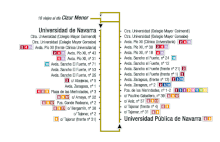Pearl cord
The term pearl cord (composed of pearl and cord ) describes a geometric figure in various areas in which linear elements alternate with round (spherical, pearl-like) elements (-oooo-).
ornamentation
Pearl cords are used in many ways in ornament art; in some cases it is difficult to distinguish it from pearl rods . It is a motif that was already known in classical antiquity (astragalus) and has been taken up again and again in various cultural areas.
Curtains made of pearl strings
Today, bead cords are also understood to mean curtains that can be hung in door or window openings as privacy and mosquito protection and consist of numerous individual threads with small balls attached to them.
Pearl cords as a graphic element
In transport, the graphic representation of a transport line (linear element) with its stops (pearls) is called a string of pearls in a line network plan .
Pearl effect
Solar eclipse
The parts of the sun or the corona that are visible during a total solar eclipse are called pearls or the pearl effect. Individual bright points of light are visible on a circular bright line on the sun's surface.
Optoelectronics
LEDs are often powered by pulsed direct current to control their brightness and to limit the current through the LED. Unlike incandescent lamps , an LED is fast enough to actually go on and off even at high frequencies . Depending on the frequency, this flicker is more or less clearly perceived. During operation, an incandescent lamp develops heat in the filament, the cooling time of which makes it a certain inertia.
The pearl effect describes a perception caused by the sluggishness of the human eye: if you look at a pulsed LED in the dark that moves relative to the viewer, the LED appears several times on a path. The angular movement of the eye creates the same effect. This makes z. B. annoyingly noticeable in some car LED taillights .



